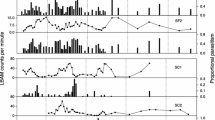Abstract
Introductions of biological control organisms offer a unique opportunity to experimentally study the process of invasion by exotic species. I used two chrysomelid beetles, Galerucella calmariensis and Galerucella pusilla, which are currently being introduced into North America for the biological control of purple loosestrife (Lythrum salicaria), to determine how the initial size of a release affects the probability that the introduced population grows and persists. I released both species into stands of their host plant at 36 sites scattered throughout central New York State using four release sizes: 20, 60, 180, and 540. I returned to these sites over the next 3 years to census the populations. For both species, the probability of population establishment increased with release size. Population growth rates also depended positively on release size. The implication from these results is that the demographic factors whose influence depends on population size or density such as demographic stochasticity, Allee effects, and genetics play important roles in the establishment of invading populations. A second set of releases was used to determine if it was at all possible for a single gravid female to found a population. Out of twenty individual females released, one female (a G. calmariensis) founded a population that persisted until the end of the study (3 generations).
Similar content being viewed by others
References
Allee WC, Park O, Emerson AE, Park T and Schmidt KP (1949) Principles of Animal Ecology. WB Saunders, Philadelphia, Pennsylvania
Beirne BP (1985) Avoidable obstacles to colonization in classical biological control of insects. Canadian Journal of Zoology 63: 743–747
Blossey B (1995) Coexistence of two leaf-beetles in the same fundamental niche. Distribution, adult phenology and oviposition. Oikos 74: 225–234
Cock MJW (1986) Requirements for biological control: an ecological perspective. Biocontrol News and Information 1: 7–16
Crawley MJ (1986) The population biology of invaders. Philosophical Transactions of the Royal Society of London, Series B, 314: 711–731
Crawley MJ (1987) What makes a community invasible? In: Gray AJ, Crawley MJ and Edwards PJ (eds) Colonization, Succession and Stability, pp 429–453. Blackwell Scientific Publications, Oxford, UK
Crowell KL (1973) Experimental zoogeography: introductions of mice to small islands. American Naturalist 107: 535–558
Dennis B (1989) Allee effects: population growth, critical density, and the chance of extinction. Natural Resource Modelling 3: 481–538
Ebenhard T (1989) Bank vole (Chethrionomys glareolus (Schreber, 1780)) propagules of different sizes and island colonization. Journal of Biogeography 16: 173–180
Elton CS (1958) The Ecology of Invasions by Animals and Plants. Methuen, London
Gabriel W and Bürger R (1992) Survival of small populations under demographic stochasticity. Theoretical Population Biology 41: 44–71
Goodman D (1987) The demography of chance extinction. In: Soulé ME (ed) Viable Populations for Conservation, pp 11–34. Cambridge University Press, Cambridge, UK
Greathead DJ (1971) A review of biological control in the Ethiopian region. Technical Communication No. 5, Commonwealth Institute of Biological Control. Commonwealth Agriculture Bureaux, Farnham Royal, UK
Green RE (1997) The influence of numbers released on the outcome of attempts to introduce exotic bird species to New Zealand. Journal of Animal Ecology 66: 25–35
Grevstad FS (1998) The Colonization Ecology of Two Loosestrife Leaf Beetles (Galerucella pusilla and G. calmariensis). PhD thesis. Section of Ecology and Systematics, Cornell University, Ithaca, New York, 170 pp
Grevstad FS (1999) Factors influencing the chance of population establishment: implications for release strategies in biological control. Ecological Applications (in press)
Grevstad FS and Herzig AL (1997) Quantifying the effects of distance and conspecifics on colonization: experiments and models using the loosestrife leaf beetle Galerucella calmariensis. Oecologia 110: 60–68
Hall RW and Ehler LE (1979) Rate of establishment of natural enemies in classical biological control. Bulletin of the Entomological Society of America 25: 280–282
Harrison S (1989) Long-distance dispersal and colonization in the Bay checkerspot butterfly, Euphydryas editha bayensis. Ecology 70: 1236–1243
Hight SD, Blossey B, Laing J and DeClerck-Floate R (1995) Establishment of insect biological control agents from Europe against Lythrum salicaria in North America. Environmental Entomology 24: 967–977
Hopper KR and Roush RT (1993) Mate finding, dispersal, number released, and the success of biological control introductions. Ecological Entomology 18: 321–330
Leigh EG Jr (1981) The average lifetime of a population in a varying environment. Journal of Theoretical Biology 90: 213–239
MacArthur RH and Wilson EO (1967) The Theory of Island Biogeography. Princeton University Press, Princeton, New Jersey
Mal TK, Lovett-Doust J, Lovett-Doust L and Mulligan GA (1992) The biology of Canadian weeds. 100. Lythrum salicaria. Canadian Journal of Plant Science 72: 1305–1330
Mayr E (1963) Animal Species and Evolution. Belknap Press, Cambridge, Massachusetts
Memmott J, Fowler SV and Hill RL (1998) The effect of release size on the probability of establishment of biological control agents: gorse thrips (Sericothrips staphylinus) released against gorse (Ulex europaeus) in New Zealand. Biocontrol Science and Technology 8: 103–115
Richter-Dyn N and Goel NS (1972) On the extinction of a colonizing species. Theoretical Population Biology 3: 406–433
Schoener TW and Schoener A (1983) The time to extinction of a colonizing propagule of lizards increases with island area. Nature 302: 332–334
Shaffer ML (1981) Minimum population sizes for species conservation. Bioscience 31: 131–134
Sheppe W (1965) Island populations and gene flow in the deer mouse, Peromyscus leucopus. Evolution 19: 480–495
Simberloff D (1989) Which insect introductions succeed and which fail? In: Drake JA, Mooney HA, di Castri F, Groves RH, Kruger FJ, Rejmanek M, and Williamson M (eds) Biological Invasions: A Global Perspective, pp 61–75. John Wiley and Sons, Chichester, UK
Soulé ME (1987) Viable Populations for Conservation. Cambridge University Press, Cambridge, UK
Stephan TS and Wissel C (1994) Stochastic extinction models discrete in time. Ecological Modelling 75/76: 183–192
Stuckey RL (1980) Distributional history of Lythrum salicaria (purple loosestrife) in North America. Bartonia 47: 3–20
Author information
Authors and Affiliations
Rights and permissions
About this article
Cite this article
Grevstad, F.S. Experimental Invasions Using Biological Control Introductions: The Influence of Release Size on the Chance of Population Establishment. Biological Invasions 1, 313–323 (1999). https://doi.org/10.1023/A:1010037912369
Issue Date:
DOI: https://doi.org/10.1023/A:1010037912369




